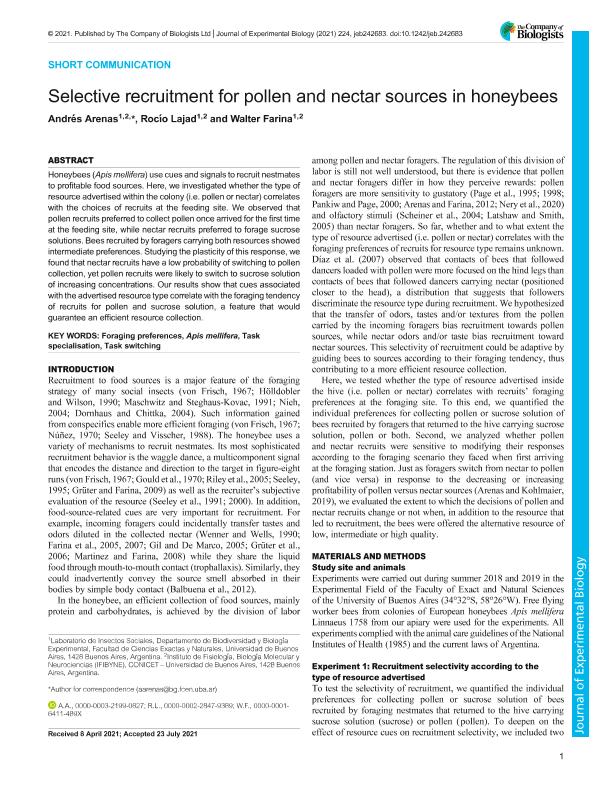Mostrar el registro sencillo del ítem
dc.contributor.author
Arenas, Andres

dc.contributor.author
Lajad, Rocio

dc.contributor.author
Farina, Walter Marcelo

dc.date.available
2024-02-27T15:38:55Z
dc.date.issued
2021-08
dc.identifier.citation
Arenas, Andres; Lajad, Rocio; Farina, Walter Marcelo; Selective recruitment for pollen and nectar sources in honeybees; Company of Biologists; Journal of Experimental Biology; 224; 16; 8-2021; 1-6
dc.identifier.issn
0022-0949
dc.identifier.uri
http://hdl.handle.net/11336/228649
dc.description.abstract
Honeybees (Apis mellifera) use cues and signals to recruit nestmates to profitable food sources. Here, we investigated whether the type of resource advertised within the colony (i.e. pollen or nectar) correlates with the choices of recruits at the feeding site. We observed that pollen recruits preferred to collect pollen once arrived for the first time at the feeding site, while nectar recruits preferred to forage sucrose solutions. Bees recruited by foragers carrying both resources showed intermediate preferences. Studying the plasticity of this response, we found that nectar recruits have a low probability of switching to pollen collection, yet pollen recruits were likely to switch to sucrose solution of increasing concentrations. Our results show that cues associated with the advertised resource type correlate with the foraging tendency of recruits for pollen and sucrose solution, a feature that would guarantee an efficient resource collection.
dc.format
application/pdf
dc.language.iso
eng
dc.publisher
Company of Biologists

dc.rights
info:eu-repo/semantics/openAccess
dc.rights.uri
https://creativecommons.org/licenses/by-nc-sa/2.5/ar/
dc.subject
APIS MELLIFERA
dc.subject
FORAGING PREFERENCES
dc.subject
TASK SPECIALISATION
dc.subject
TASK SWITCHING
dc.subject.classification
Zoología, Ornitología, Entomología, Etología

dc.subject.classification
Ciencias Biológicas

dc.subject.classification
CIENCIAS NATURALES Y EXACTAS

dc.title
Selective recruitment for pollen and nectar sources in honeybees
dc.type
info:eu-repo/semantics/article
dc.type
info:ar-repo/semantics/artículo
dc.type
info:eu-repo/semantics/publishedVersion
dc.date.updated
2024-02-20T15:02:47Z
dc.journal.volume
224
dc.journal.number
16
dc.journal.pagination
1-6
dc.journal.pais
Reino Unido

dc.description.fil
Fil: Arenas, Andres. Consejo Nacional de Investigaciones Científicas y Técnicas. Oficina de Coordinación Administrativa Ciudad Universitaria. Instituto de Fisiología, Biología Molecular y Neurociencias. Universidad de Buenos Aires. Facultad de Ciencias Exactas y Naturales. Instituto de Fisiología, Biología Molecular y Neurociencias; Argentina
dc.description.fil
Fil: Lajad, Rocio. Consejo Nacional de Investigaciones Científicas y Técnicas. Oficina de Coordinación Administrativa Ciudad Universitaria. Instituto de Fisiología, Biología Molecular y Neurociencias. Universidad de Buenos Aires. Facultad de Ciencias Exactas y Naturales. Instituto de Fisiología, Biología Molecular y Neurociencias; Argentina
dc.description.fil
Fil: Farina, Walter Marcelo. Consejo Nacional de Investigaciones Científicas y Técnicas. Oficina de Coordinación Administrativa Ciudad Universitaria. Instituto de Fisiología, Biología Molecular y Neurociencias. Universidad de Buenos Aires. Facultad de Ciencias Exactas y Naturales. Instituto de Fisiología, Biología Molecular y Neurociencias; Argentina
dc.journal.title
Journal of Experimental Biology

dc.relation.alternativeid
info:eu-repo/semantics/altIdentifier/doi/http://dx.doi.org/10.1242/JEB.242683
Archivos asociados
